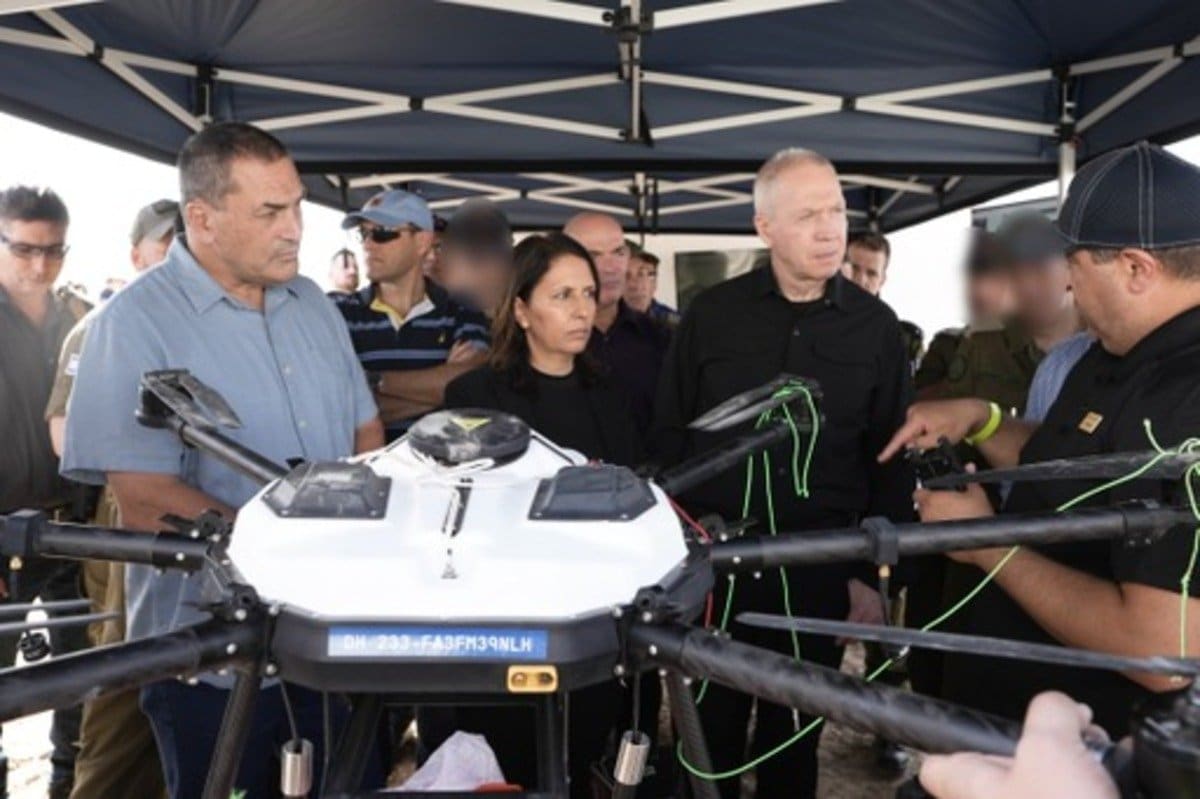Israel has run a competition in an effort to source new ways of batting away incoming drones. It is a fresh reminder of the grave challenges that cheap, often simple, unmanned technology is posing to militaries across the world.
Senior Israeli officials from the government and the military, including Defense Minister Yoav Gallant, headed what Israel’s Defense Ministry called a “first-of-its-kind trial” at an unspecified location in southern Israel on Monday. It was designed to help pinpoint technology tailored to intercept incoming uncrewed aerial vehicles (UAVs).
Israel has an advanced network of air defense systems, including its famous Iron Dome missile system that can intercept incoming short-range attacks at a distance of around 70 kilometers, or just over 40 miles. Other systems work alongside the Iron Dome to intercept attacks at different distances and altitudes. The David’s Sling and Arrow systems are meant to take out missiles and rockets from further away.
However, despite Israel’s advanced web of air-defense systems, relatively low-tech, cheap drones lobbed over into northern Israel by Lebanese-based Hezbollah have proved difficult to tackle.

Smoke billows from forest fires near the southern Lebanese village of Shebaa, close to the northern border of Israel, following the shooting down of a drone by the Israeli army on July 4, 2024. Senior Israeli officials from the government and the military headed a “first-of-its-kind trial” for anti-drone tech in southern Israel on Monday.
RABIH DAHER/AFP via Getty Images
The Iran-backed political party and influential militant group has been exchanging fire with Israel for over a year, and the Israelis are more than two weeks into ground operations in the south of Lebanon. The Israeli Defense Forces (IDF) have extensively targeted Lebanon, including the capital, Beirut, with airstrikes it said homed in on Hezbollah infrastructure and commanders.
When Newsweek visited northern Israel in mid-September, IDF Lieutenant Colonel Dotan Razili told reporters during a field briefing around 5 miles from the Lebanon border that Israel had a “challenge” on its hands locating and shooting down Hezbollah’s cheap drones.
Interceptor missiles fired by missile air defense systems typically dwarf the costs of acquiring and deploying an attack drone.
Asked if the northern forces have enough low-tech solutions for Hezbollah drones, Razili said: “Not as much as we’d like.”
An Israeli industry source told Newsweek last month all defense companies in Israel were working toward a solution for inexpensive drone attacks. Another said this may include looking back at older systems.
Fighters in Ukraine have successfully used large-caliber machine guns and equipment such as the German-made Gepard self-propelled anti-aircraft guns to take down the Shahed attack drones, originally designed and provided by Iran, that Russia has consistently used against Ukraine.
“The UAV threat is a multi-arena threat originating from Iran, which supplies UAVs to Lebanon, Yemen, and Iraq, and even launches them itself,” Gallant said in a statement.

An image provided by the Israeli defense ministry shows the “first-of-its-kind trial” to find new ways to tackle the threat posed by uncrewed aerial vehicles (UAVs). “The UAV threat is a multi-arena threat originating from Iran,” said Israeli Defense Minister Yoav Gallant.
Ariel Hermoni, Israel Ministry of Defense
In April, Iran launched more than 300 missiles and drones at Israel in its first-ever direct attack on the Israelis from Iranian territory. Another large-scale attack saw Tehran fire almost 200 ballistic missiles toward Israel at the start of October.
To face the threat posed by UAVs, Gallant said on Tuesday that Israel “must concentrate the national effort of all bodies dealing with the issue to produce operational solutions quickly.”
“Countering the UAV threat is a critical national priority,” added Eyal Zamir, the director-general of Israel’s Defense Ministry.
The IDF said earlier this week that a UAV launched by Hezbollah had killed four Israeli soldiers in an “army base adjacent to Binyamina,” a town located between the northern Israeli cities of Netanya and Haifa.
Representatives from Israel’s major defense names, including Elbit Systems, Rafael Advanced Defense Systems, and Israel Aerospace Industries (IAI) took part, the Israeli government said. Smaller startup firms were also invited.
Prototypes showcased at the trial were developed under the supervision of Israel’s Directorate of Defense Research and Development, falling under the Defense Ministry and the IDF.
Solutions chosen for their promise after this “groundbreaking event” will be quickly developed and rushed through operational testing, the Israeli Defense Ministry said.
The idea is to deploy new counter-drone technology “within months,” the government said.
“Yesterday’s competition, in which small and large defense industries presented various solutions, from the most sophisticated to simple ones, advances us another step forward,” Gallant said.
Elbit Systems put forward a system named by Israel’s Defense Ministry as Iron Hawk, which uses interceptor drones to take out hostile UAVs. IAI brought a system named as “Precise Falcon” to the table, as well as an “additional advanced system for long-range interception capabilities.”
Israel’s government said Rafael had demonstrated a system dubbed Typhoon, able to take out various threats.






